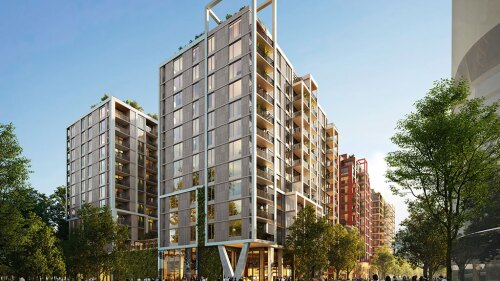New research shows that transit-oriented developments (TODs) may be saddled with a surplus of parking that is taking a big bite out of project costs.
TODs have become a key economic development strategy for both urban and suburban communities that are trying to promote dense, walkable communities and reduce vehicle trip traffic. It may seem contrary to that goal, but developers still need to account for the parking needs of people who live, work, and shop in those mixed-use projects.
A new TOD parking study suggests that developers and planners need to rethink the formulas they are using to calculate parking, especially as it relates to more urban projects. The report, Empty Spaces, which was released by Smart Growth America in partnership with the University of Utah’s College of Architecture and Planning, found that even some of the top TOD projects in the United States had built too much parking. The study focuses on five case studies to illustrate parking supply and demand, as well as highlight some strategies solutions that TODs can use to reduce parking.
Plenty of compelling reasons explain why “rightsizing” parking stalls at TODs is a high priority for developers. Structured parking is expensive to build and is not the highest and best use for premium land next to transit stations. The per-stall cost on structured parking can range from $19,000 to $75,000 on the very high end in dense urban areas.
“Too much can render projects unviable financially and clearly can impact the affordability of whatever you have built,” says Chris Zimmerman, vice president for economic development at Smart Growth America. At the same time, parking also can be a critical factor in a project’s success, and too little parking can detract from the attractiveness and value of a project. “If we can make an adjustment on [parking], we might see a significant increase in the supply and perhaps also the affordability of transit-oriented development, which is why this new research is so exciting,” he says.
Rethinking Outdated Assumptions
Developers often rely on industry manuals such as the Institute of Transportation Engineers (ITE) Trip Generational Manual and the ITE Parking Generation Manual for guidance on parking. However, those data come from suburban locations that often have little pedestrian traffic. The Empty Spaces study provides quantitative support for the notion that parking that is required for urban TODs is substantially less than has previously been thought.
Specifically, the Empty Spaces report studied five specific mixed-use TOD projects that included the following:
- The Englewood, Colorado, TOD is an open-air, mixed-use development that replaced a former regional mall.
- The Wilshire/Vermont TOD in the Koreatown area of Los Angeles is situated in a very dense population and at a busy transit corner.
- Oakland, California’s Fruitvale Transit Village features a pedestrian plaza lined by retail businesses that is adjacent to a Bay Area Rapid Transit station.
- The Redmond, Washington, TOD in the Seattle region is a former park-and-ride lot and bus transfer facility that is now home to a mixed-use, multistory apartment and retail development.
- Rhode Island Row in Washington, D.C., is located on the site of a former surface parking lot for the Rhode Island Avenue Metro station.
In all five TODs studied, peak parking occupancy as a percentage of ITE parking supply guidelines was less than 50 percent. Englewood, which was the largest and most auto-oriented TOD, had the highest use percentage, with peak demand coming in at 46 percent of the recommended ITE amount. “In these developments, even though they are supplying a lot less parking than ITE suggests, they are not using all of it,” says Reid Ewing, chief author of the report and a professor in the Department of City & Metropolitan Planning at the University of Utah. Fruitvale Village used the highest percentage of its available supply at 84 percent, while Englewood had the biggest surplus, with peak parking occupancy at 58.3 percent as a percentage of its supply.
Lessons Learned
The research findings speak to the point that TOD developers can realize substantial savings and generate more value by better managing parking supply with demand. So why do these TODs use less parking than originally thought? One, there is more pedestrian traffic and more shared vehicle trips. In addition, TODs that charged parking fees, such as a pay lot for people who come to shop or an added monthly parking fee for apartment renters, ended up depressing the demand.
In addition, there is room for improvement even in those TODs studied. Only one of the five TODs—Englewood—had shared parking between the park-and-ride transit users and the TOD residents and shoppers. So, increasing shared parking is one opportunity to reduce parking supply as demand for different uses peaks at different times of the day, says Ewing. Another takeaway from the research is that developers need to work closely with the local jurisdictions that set codes and zoning dictating parking requirements. For example, the Redmond TOD worked proactively with the city of Redmond to set a new precedent for lower parking requirements in the region.
The additional research is helping both developers and city planners rethink parking requirements as the way that people use transit, vehicles, and other transportation alternatives is shifting. The TOD Group is currently working as the master developer on the Clear Creek Transit Village, a 21-acre (8.5 ha) TOD project in suburban Denver next to the Federal Boulevard train station for the metro’s Gold Line rail corridor.
“On the one hand, we want to create an environment that encourages people who want to live near transit to be able to move there without a car,” says John L. Renne, managing director at the TOD Group and director of the Center for Urban and Environmental Solutions (CUES) and associate professor in the School of Urban and Regional Planning at Florida Atlantic University in Boca Raton, Florida. “By the same token, we know that people are going to need to have access to a car for many of their trips,” says Renne.
The TOD Group is evaluating research data and best practices on different parking scenarios to create a maximum parking ratio for the project. In addition, the company developed a transportation management plan that provides guidance on how the company can create incentives to reduce parking use. For example, the project runs adjacent to a local bike path, and bicycle parking will be required on every block. As the project moves closer to the development phase, the developer also plans to contact organizations to have car sharing and bike sharing on site.
As part of its development agreement with the jurisdiction—in this case, Adams County—the TOD Group agreed to review parking at each phase of the project to evaluate how parking is being used to allow for flexibility to increase or decrease parking based on actual use. “One of the key costs of construction for any TOD is parking,” says Renne. “Building structured or underground parking is very, very expensive. So, if you can reduce the amount of parking that you need to build, you can create other benefits, such as more housing affordability,” he says.
3 The Denver region’s Englewood station remains the one exception or outlier in these findings. In an effort to generate tax revenue from big-box retailers, the city of Englewood decided to build a “hybrid-TOD” that divides the development into zones of TOD and of big-box retail. The resulting parking supply and vehicular trip generation exceed the other TODs in this study. Even so, the study found the peak demand for parking at the hybrid-TOD still to be much lower than suggested in ITE’s guidelines.








